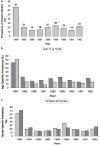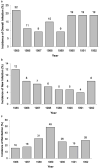Factors affecting infection or reinfection with Schistosoma haematobium in coastal Kenya: survival analysis during a nine-year, school-based treatment program
- PMID: 16837713
- PMCID: PMC3419477
Factors affecting infection or reinfection with Schistosoma haematobium in coastal Kenya: survival analysis during a nine-year, school-based treatment program
Abstract
Urinary schistosomiasis remains a significant burden for Africa and the Middle East. Success of regional control strategies will depend, in part, on what influence local environmental and behavioral factors have on individual risk for primary infection and/or reinfection. Based on experience in a multi-year (1984-1992), school-based Schistosoma haematobium control program in Coast Province, Kenya, we examined risk for infection outcomes as a function of age, sex, pretreatment morbidity, treatment regimen, water contact, and residence location, with the use of life tables and Cox proportional-hazards analysis. After adjustment, location of residence, age less than 12 years, pretreatment hematuria, and incomplete treatment were the significant independent predictors of infection, whereas sex and frequency of water contact were not. We conclude that local physical features and age-related factors play a predominant role in S. haematobium transmission in this setting. In large population-based control programs, treatment allocation strategies may need to be tailored to local conditions on a village-by-village basis.
Figures




References
-
- King CH, Dickman K, Tisch DJ. Reassessment of the cost of chronic helmintic infection: a meta-analysis of disability- related outcomes in endemic schistosomiasis. Lancet. 2005;365:1561–1569. - PubMed
-
- King CH. Disease in schistosomiasis haematobia. In: Mahmoud AAF, editor. Schistosomiasis. London: Imperial College Press; 2001. pp. 265–296.
-
- WHO. Prevention and control of schistosomiasis and soiltransmitted helminthiasis: report of a WHO expert committee. World Health Organ Tech Rep Ser. 2002;912:2–5. - PubMed
-
- van der Werf MJ, de Vlas SJ, Brooker S, Looman CW, Nagelkerke NJ, Habbema JD, Engels D. Quantification of clinical morbidity associated with schistosome infection in sub-Saharan Africa. Acta Trop. 2003;86:125–139. - PubMed
-
- Chen MG, Mott KE. Progress in assessment of morbidity due to Schistosoma haematobium infection. Trop Dis Bull. 1989;86:R1–R36.
Publication types
MeSH terms
Substances
Grants and funding
LinkOut - more resources
Full Text Sources
